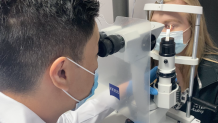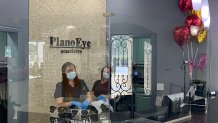Since May 8, eye doctor offices have been allowed to resume regular eye care under Gov. Greg Abbott’s reopening plan, but many have waited until just the past week or so to do that.
That’s because the eyes are a major portal of entry for the virus and optometrists are going above and beyond to prepare their offices and staff to be safe.
Dr. Kim Castleberry, CEO of Plano Eye Associates and a board member with the Texas Optometric Association, said many eye doctors actually stayed open only for emergency situations during the crisis like eye infections, strokes and vision loss. They were able to keep a lot of those cases out of the emergency rooms to ease pressures at local hospitals.
He said they’re consistently trained on infection control and dealing with contagious infections in the eye, so it really wasn’t a stretch to help them prepare for the 2019 novel coronavirus.

“We were already using masks and gloves for in-office surgical procedures and many of our medical exams. So when COVID came along, all we really had to do was put PPE on everyone - patients and doctors alike,” said Castleberry.
Local
The latest news from around North Texas.
Castleberry gave us a look into what many offices, including his own, are doing right now.
Since eye doctors are just inches from a patient’s face, it’s impossible to social distance, so they are in full PPE gear from head to toe including masks, shields, gowns and lab coats.
Staff are also sanitizing everything and leaving signs to communicate what has and hasn’t been cleaned yet.
Patients are checking in electronically in the parking lot and even they have to put on PPE as soon as they walk in.
“When they actually come in the office, they are greeted with a PPE stand so they put gloves on, masks on,” said Castleberry. “Even before this, we had put in hospital-grade air scrubbers into our air conditioning vents and we replaced our countertops with medical-grade laminate to provide a nice, clean germ-free surface.”
When patients check out, they’ll be greeted by glass partitions that have been installed at the main desks. On the lab and exam room side of things, microscopes and eye machines also have partitions to keep workers and patients safe.

“Fear is probably the worst thing that we have that’s keeping people from our offices, not understanding that in our practice I think our practice is one of the safest places to be,” said Castleberry.
According to the American Optometric Association, the virus not only spreads through person to person contact but it can also spread from contact with contaminated surfaces or objects that have the virus on it by touching the surface and then touching your mouth, nose or eyes.
“In fact, one of my physicians in my practice actually contracted COVID-19 from a patient early on, before we really knew what was going on, that had traveled in from China,” said Castleberry.
That employee recovered and no one else contracted the virus, which he said speaks to the level of hygiene and safety practices eye doctors practice even on a normal basis.
As far as what you need to be doing at home to protect your own eyes, you might want to start with your eyeglasses or sunglasses. You might want to add those to the list of things you sanitize.
“People fiddle with their eyeglasses all the time and people know to wash their hands, but they don’t know to wash their eyeglasses,” said Castleberry. “Because while germs are not transmitted through surfaces very easily, they certainly can be. Especially if it’s up close and personal like your eyeglasses.”
*Map locations are approximate, central locations for the city and are not meant to indicate where actual infected people live.



